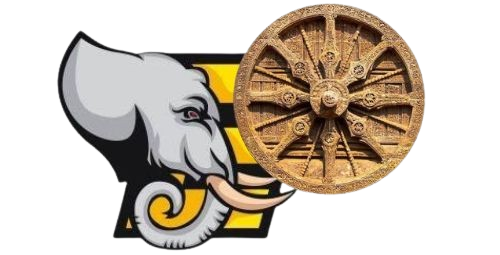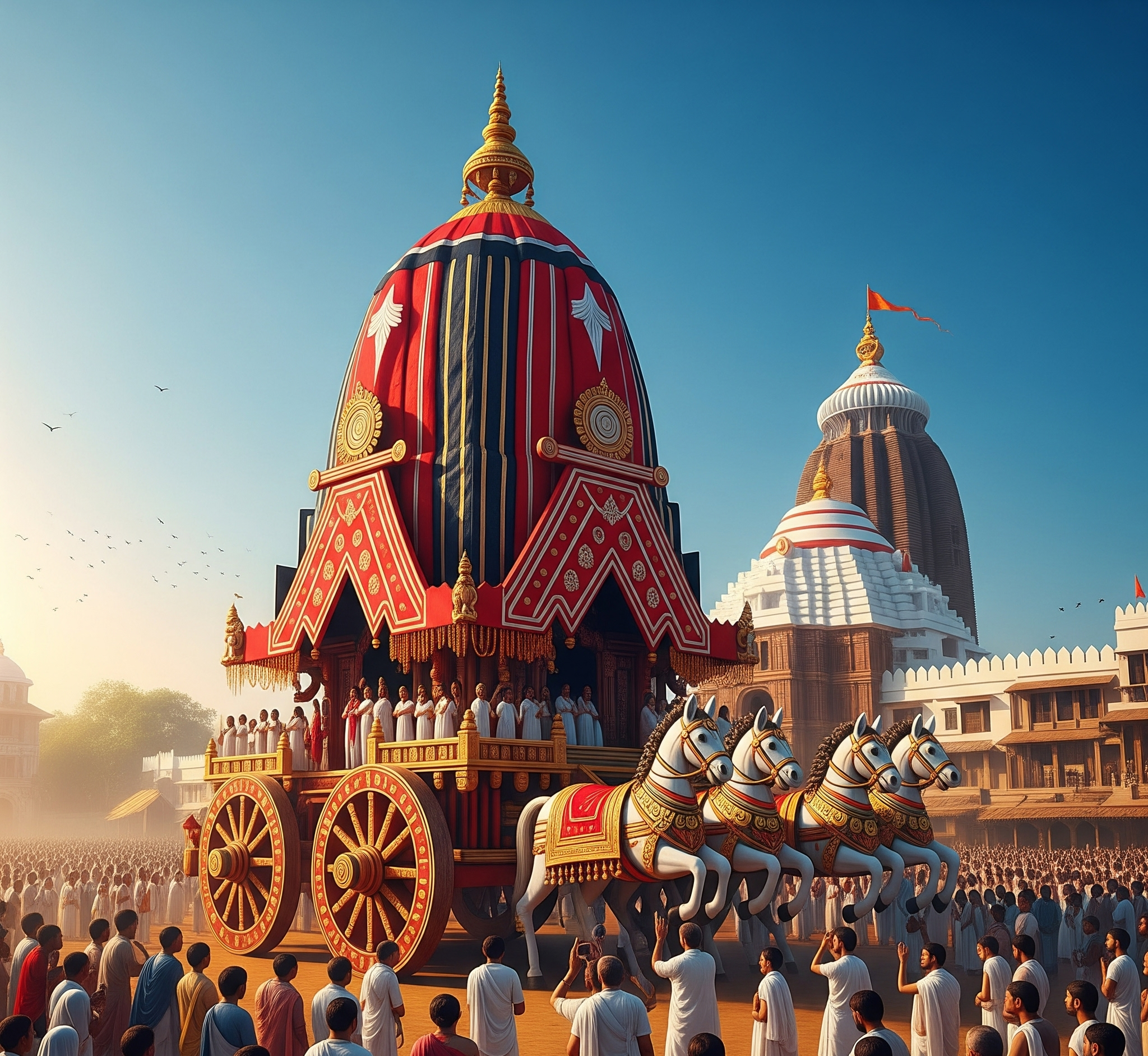The grandeur of the Jagannath Rath Yatra, celebrated annually in the sacred town of Puri, Odisha, is unmatched in its scale, symbolism, and devotion. Among the three majestic chariots that roll through the streets of Puri, the one that carries Goddess Subhadra, the divine sister of Lord Jagannath and Lord Balabhadra, holds a unique and graceful presence. This chariot, known as Debadalana, is a symbol of feminine strength, spiritual elegance, and the central role of divine womanhood in Jagannath culture.
Unlike her brothers’ imposing and more colorful chariots, Subhadra’s Debadalana Rath reflects both power and serenity. It is not only a vehicle of a goddess but a sacred embodiment of Shakti (divine feminine energy) that complements the Vaishnavite traditions of Puri.
This article explores every detail and origin of the Debadalana Rath, its design, symbolism, rituals, cultural relevance, and spiritual meaning.
Who Is Goddess Subhadra?
In the sacred triad of the Jagannath Trinity, Subhadra represents the divine feminine, compassion, and balance. She is regarded as the younger sister of Lord Jagannath (a form of Krishna) and Lord Balabhadra (Balaram). In some traditions, she is identified with Mahalakshmi, the goddess of prosperity; in others, she is seen as Durga or Parvati, the embodiment of strength and protection.
Goddess Subhadra is worshipped in a square-shaped idol, unlike the rounded or semi-circular features of her brothers. Her expression is calm and centered, a representation of equilibrium and devotion—qualities that guide devotees toward a balanced spiritual life.
Her chariot, Debadalana, reflects her grace, spiritual radiance, and subtle authority within the divine sibling trio.
Origin of the Name ‘Debadalana’
The name Debadalana is derived from two Sanskrit words:
- “Deba” meaning “Deity” or “Divine”
- “Dalana” meaning “crusher” or “conqueror”
Thus, Debadalana can be interpreted as “She who destroys evil or obstacles in the path of the divine.” This name symbolizes Subhadra’s role not just as a divine sister, but as a protector of dharma and a destroyer of negativity. Her chariot is not merely a transport—it is a symbol of spiritual conquest over ignorance.
In some regional traditions, Debadalana is also referred to as Darpadalana, meaning “breaker of pride,” showcasing the goddess’s power to humble arrogance and restore righteousness.
Design and Architecture of Debadalana Chariot
The construction of Debadalana is a meticulous and sacred process that begins during Akshaya Tritiya, when the logs for all three chariots are sanctified and carved by hereditary artisans known as Viswakarma Sevayats.
Here are the defining features of Debadalana Rath:
1. Dimensions and Structure
- Height: Approximately 42 feet (smaller than Jagannath’s Nandighosa and Balabhadra’s Taladhwaja)
- Wheels: 12 wooden wheels, each around 6 feet in diameter
- Color: Bright Red and Black, symbolizing power (red) and deep cosmic energy (black)
- Canopy: Made with cloth of red and black stripes
The compact and elegant size of the chariot matches the spiritual representation of Subhadra as a composed and inner-focused deity, unlike the more expansive nature of her brothers.
2. Charioteer and Horses
- Sarathi (charioteer): Arjuna, the Pandava prince and devotee of Krishna, guides Debadalana, highlighting his reverence for divine femininity.
- Horses: Four black-colored horses named Rochika, Mochika, Jita, and Aparajita, signifying discipline, strength, control, and victory.
The black horses pulling her chariot symbolize the inward journey of the soul—subtle, silent, and strong.
3. Guard Deity and Emblems
- Guardian deity: Vanadurga, a fierce form of the goddess who protects the chariot during the journey.
- Emblem: Lotus flower, representing purity, beauty, and divine feminine energy emerging from the depths of consciousness.
The lotus is also a symbol of detachment and spiritual awakening, both of which are qualities deeply associated with Goddess Subhadra.
Rituals Associated with Debadalana
Several rituals and customs are strictly followed in association with Debadalana during the Rath Yatra and the days leading up to it:
1. Pahandi Bije (Procession)
Subhadra is brought from the sanctum of the Jagannath Temple to her chariot in a traditional ritual known as Pahandi, where the deity is carried on the shoulders of servitors with rhythmic chants, cymbals, and gongs. Her movement is marked with grace and devotion.
2. Chhera Pahanra (Sweeping Ceremony)
The Gajapati King of Puri, regarded as the foremost servitor of the Lord, performs the Chhera Pahanra, where he sweeps the chariot platform with a golden broom, symbolizing humility before the divine. He performs this ritual for all three chariots, including Debadalana.
3. Rath Yatra Day
Subhadra, along with her brothers, begins the divine journey from the Jagannath Temple to the Gundicha Temple, their aunt’s house. This journey symbolizes a spiritual retreat, and Subhadra’s presence adds grace and power to this cosmic journey.
During the procession, thousands of devotees pull the chariots with ropes, sing devotional songs, and chant “Jai Maa Subhadra!” The spectacle of Debadalana moving through the streets is considered auspicious and spiritually purifying.
Cultural Significance of Debadalana
Debadalana is not just a vehicle; it represents a living tradition of goddess worship in Odisha and beyond. Unlike many other Hindu traditions where goddesses are represented separately, Puri’s triad places the goddess at the center of the male divine energy—not as subordinate, but as equal.
Subhadra’s chariot procession is a visual testament to the Vedic concept of feminine power as a balancing and vitalizing force in creation. Her journey also underscores the message that divine grace requires balance between masculine and feminine energies—between action and compassion, strength and serenity.
Symbolism in Modern Context
In modern interpretations, Debadalana reflects:
- Women’s empowerment: The central role of Subhadra in Rath Yatra emphasizes respect and reverence for the divine feminine.
- Balance in life: Her calm demeanor between her dynamic brothers signifies the importance of balance and emotional stability in the chaos of the world.
- Spiritual journey inward: While the larger chariots may symbolize external journeys, Debadalana represents the inner pilgrimage, the quiet transformation that occurs within.
Conclusion
The Debadalana chariot of Goddess Subhadra is not merely a part of the Rath Yatra—it is the very heart of the spiritual celebration. Its elegance, sacred design, and symbolic journey reflect the timeless reverence of the feminine divine in Hinduism. The origin and rituals of Debadalana remind us that amidst grandeur and power, it is the quiet force of grace, balance, and purity that sustains the spiritual order of the universe.
As her chariot glides through the streets of Puri, surrounded by the roar of devotion and divine energy, Debadalana carries not only a deity—but a legacy of compassion, equilibrium, and sacred womanhood.


